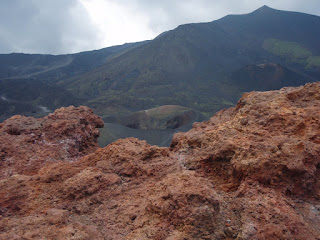Arriving in Sicily was great
– the weather was hotter than the mainland and as we drove through towns and
villages en route to our first stop near Mt Etna, it felt nicely Mediterranean.
Our chosen campsite, Mokambo, was nestled in the plains below Etna and from our
pitch we had a champion view up to the volcano.
After a quick pow-wow to
look at the costs of getting a day trip up to Etna from the campsite (80 Euros
each), we decided to brave it and take the van instead! We’d learned from a
couple we got chatting to on the site that it was possible to sleep over at the
2000m refuge – so, armed with our experience of ascending Vesuvius in an Iveco
converted into a tram, we decided to do Etna in one converted into a camper!
The journey up was slow –
very slow, as the switchback road took us via a less than direct route. In fact
it took us the best part of two hours to do 26 miles!
Luckily for us we seemed to
meet more traffic on the way down than the way up – or else we would have had a
long tail of irate Italians behind us. The van is a ‘sedate’ climber of steep
gradients, which we knew from our journeys across the Pyrenees in previous
years – but this was the first time we had ever heard the cooling fan turn on
just as the needle reached the red bit on the gauge! We’d heard from fellow
Iveco owners that it sounded a bit like a hovercraft when it does cut in – and
indeed it did! The views across the lava fields were well worth the temperature
related tension and snail-like pace though.
When we got to the 2000m
refuge we discovered that we could indeed stay over for the night at the
princely sum of 12 Euros for 24 hours of parking and decided that, rather than
spend the 50 Euros or so each to get the cable car and then Unimog to the
summit in the clouds, we’d have a bit of a yomp and explore some of the more
recent craters and lava fields from the 1980s eruptions.
These recent craters are
amazing. The lava reached out towards the coast in the background of this one
and we could see the lava fields on the drive up. The impact of recent
eruptions was clear to see – parts of the slopes between 2000m and 3300m looked
otherworldly and alien.
Others, which had avoided
the lava flow, were more lush and almost Alpine.
The next pic shows a view of
the summit of Etna from the peak of one of the more recent eruptions – the red
lava being typical of these.
Yet not more than 200m away
in a different direction, the landscape retuned to the almost ‘lush’ Alpine
terrain we had seen earlier.
As we wandered the lava
fields we could hear the sound of a vehicle from above – and not long after,
one of the Unimogs that are used to do the final bit of the ascent to the summit
came past us on its way down to the refuge at the end of a day ferrying peeps
up the final bit of the ascent. I’d always hankered after one of these to
convert to a camper – until I found out the fuel consumption. Still, they do
look pretty cool!
As the daylight started to
fade, we made our way back to the refuge and the van. This is me at the top of
one of the 1980s eruption craters.
And this is a wo/man and dog
on the other side of the same crater.
By about nine o’clock all
that was left after the departure of the day-trippers to the refuge, was a
motley collection of campervans – and an almost obligatory chorus of barking
dogs. Luckily, unlike their Spanish counterparts, the Italian dogs fell quiet
before midnight, leaving us with a spectacular view out to Catania – where the
lava flows did reach in days gone by.
After a very windy, cold but
peaceful night under the summit of Etna, we woke the next day to the mandatory
‘cloud cap’ that Etna seems to keep during daylight hours.
Having really enjoyed the
novelty of a cool night, we were already keen for a return to the Sicilian heat
– so we set our course for a campsite on the coast near Syracusa that had been
recommended to us by fellow travellers – with the caveat that it was ‘difficult
to access’ for campervans. Well we shall see!
S.













No comments:
Post a Comment